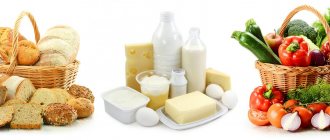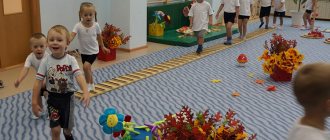Lapbook information content
A laptop on the theme “Vegetable garden on the window” can be filled with a variety of information. Possible blocks:
The pictures can also be used as answers to riddles about vegetables.
Each card contains an image of a vegetable and brief interesting information about it.
You need to take several plants that are well known to children, including those that grow in a mini-garden in a group
Below each part of the plant is its description.
It’s a good idea to copy the tips from the seed packages into a booklet.
Information for passports can again be taken from seed packages
Cards reflect the key stages of planting
A growth calendar will allow children to record their observations of plants
Children themselves can draw colorful pictures; the teacher will only draw the outlines with a simple pencil
Preschoolers usually love to look at their photographs, so they can be placed in a lapbook
Riddles for kids should be short and simple, for older people - more intricate
Poems should be short, you can take humorous ones
Such pictures will be relevant in the younger and middle groups, since vegetables are a simple object for coloring
You need to enter vegetables horizontally, and fruits vertically.
A selection of riddles about vegetables
A selection of poems about vegetables
A selection of sayings about vegetables
Bird watching calendar
Winter feeding of birds is one of the important conservation and environmentally significant activities, the correct organization of which a kindergarten can provide real assistance in preserving their species diversity. Feeding birds is a simple, but pedagogically appropriate and educationally highly effective activity in which children of all age groups can participate. Birds go hungry in winter: daylight hours are short, food is scarce, and energy costs are difficult to replenish. It is especially difficult for them in severe frosts: from the cold, but mainly from hunger.
When organizing winter feeding of birds, the teacher does the following:
— Starts feeding (in central Russia) at the end of October - beginning of November (at this time, wintering birds approach human dwellings in search of food).
— On the territory of the kindergarten, several stationary wooden feeders are hung at a considerable distance from each other (not near the playgrounds) - at the rate of one for 2-3 groups. They can be hung on second floor windows or in places where they will be clearly visible from the windows.
— Teachers teach children to collect bread crumbs and leftover dry cereals in a special jar with a lid, regularly place food, and seeds of wild herbs collected in the warm season on feeders. Groups attached to one feeder, after feeding the birds for a week, replace each other and monitor it so that there are no breaks.
A clear organization of feeding birds at the beginning of winter is of great importance: the birds get used to the feeding place - tits, pigeons, flocks of sparrows stay close to the site, regularly appear near the feeders, and wait for people on the branches of nearby trees and bushes. After the New Year, the cycle of observations of wintering birds begins. At the same time, observations are recorded in a special calendar for one to two weeks. This calendar, like others, is a model. It has three gradually increasing complexity modifications: for younger and middle age, for senior and preparatory school groups.
The calendar for younger preschoolers, as well as the upper part of the calendar for the older group, are filled with cards with drawings of wintering birds. Observations are recorded in this way every day anew and do not leave graphic “traces”. The lower part of the calendar of the senior group and the entire calendar of the preparatory group for school are filled out differently: every day, colored “checkmarks” (symbolic designation of birds) are placed in the stripes of the corresponding day.
Calendars differ not only in the way they record observations, but also in their content. The volume of simulated content for older preschoolers is much larger: a time parameter is introduced (days of the week), various features of bird behavior are recorded (who is waiting for food, who eats on the feeder and who is under it, who flies over the site and watches the birds' dinner). In the calendar of the preparatory school group, you can record the weather and composition of food (external conditions), against which the birds visit the feeding site.
The main content of the calendars of all age groups (and the only one for the younger ones) is the composition of the birds. Filling out the calendar once every two weeks at the height of winter feeding allows children to get acquainted with the diversity of wintering birds, the characteristics of their appearance and behavior.
Entering the calendar three times in the school preparatory group - at the very beginning of feeding (end of October), at its height (January) and at the end of March - makes it possible to trace the dynamics of changes in the composition of birds associated with their autumn-spring migrations: in the fall you can still see wild ducks, see the flight of cranes, in March - record the arrival of rooks and ducks in the calendar. Thus, the oldest preschoolers will create a more detailed graphic model of the life of birds in the cold season than in the previous group. Well-designed, clearly drawn winter bird observation calendars become visual demonstration aids that can be used in a variety of ways.
Subject modeling of various natural objects
In addition to modeling the natural processes of nature (seasonal changes, growth and development of living beings), children can make a whole range of models that reproduce individual phenomena or objects of nature and allow preschoolers to learn their essential aspects. Graphic modeling can be used to draw up a map of a group’s premises, a kindergarten site, or the territory of the immediate natural environment. Modeling the space in which a child’s life takes place helps him take a fresh look at the world around him. Drawing up a schematic map is especially useful when creating an ecological trail, determining a route into nature along which children regularly take walks and excursions.
With children of senior preschool age, you can make a homemade globe (from papier-mâché on a ball or balloon, or in another way).
Such a globe allows you to provide information about the Earth gradually and in small portions: during the school year, glue continents, designate states, cities, seas; which one way or another came into the children’s field of vision, print their names in block letters. Preschoolers are of great interest in traveling around the globe and gluing images of animals living in the oceans on other continents.
It is useful to demonstrate cardboard models that represent one of the natural and widespread phenomena of the animal world - the protective coloring of the integument: camouflage, repellent, dismemberment. The teacher himself or together with the children can make a model of a peacock butterfly on the bark of a tree and, using movable wings, demonstrate either the camouflage coloring of their lower side, or the bright and frightening, eye-like spots on their upper side. The model can be used many times, showing the morphofunctional adaptability of the insect to the environment: the butterfly rests motionless on a tree, with its wings folded (at this moment it is protected by camouflage coloring); the butterfly is alarmed - it opens and closes its wings, scaring away everyone who approaches it, with large blue “eyes” on the upper side of the wings.
Another model makes it possible to form in children a generalized idea of camouflage as such. After demonstrating 3-4 figures (geometric and animal-shaped) on the motley and white part of the panel in a stationary state and in motion along the slot, children begin to understand that in order to disguise any object, a combination of two conditions is necessary: color matching the background and immobility . In this way, the objectively existing, but hidden from the child’s perception, connection between the structure, behavior of the animal and its habitat becomes obvious.
It is advisable to include in children’s cognitive activity such object models with which they can perform practical actions. Preschoolers can be shown that the length of the legs affects the speed of movement: the longer the legs, the faster the animal moves in space. The process of modeling this phenomenon can be organized as follows: on the table in front of each pair of children, you need to put a large sheet of white paper with a starting line marked on it and two paths along which cardboard “legs” will walk—one child has long ones, and the other has short ones. Each of the children takes the same number of steps (for example, five), marking them with a pencil on the path, and then compare the result: the one with the longer “legs” has gone further. They take more steps, change “legs”, but the result remains the same - the longer “legs” always go further. By putting the goishkas of different animals on top of them, the simulation can be turned into a competition game “Which of the animals will run to the finish line faster.”
An interesting model of a bird of prey can be made from black paper. By attaching it with a rubber band to the end of a stick, it is easy to demonstrate the aerial attack and defensive behavior of mountain animals. An attack by a predator on prey in nature is almost impossible to see (and preschoolers don’t need to), so modeling in this case becomes especially appropriate. Thus, models and modeling make it possible to demonstrate significant ecological connections in nature, therefore the process of modeling and the use of ready-made models is a method of environmental education.


